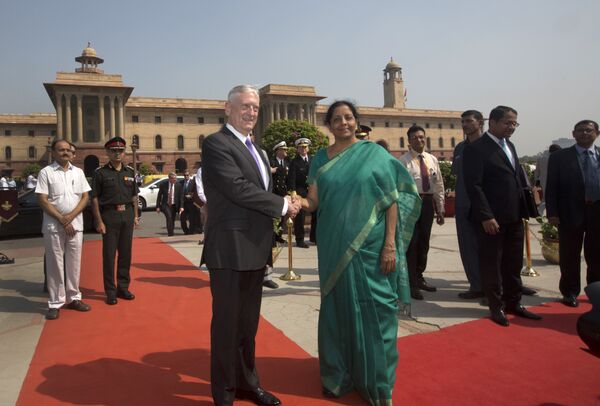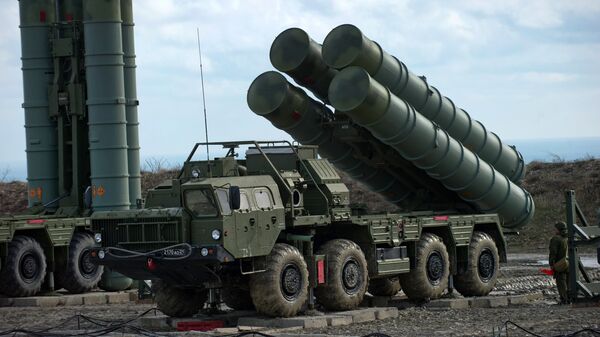While Turkey has made its mind up on purchasing Russian-made S-400 Triumf air defence systems regardless of Washington's threats, the Trump administration has increased pressure on India, warning it against acquiring the advanced anti-aircraft weapon and citing sanctions under the 2017 Countering America's Adversaries Through Sanctions Act (CAATSA) ahead of Secretary of State Mike Pompeo official visit to the country.
However, the Indian Ministry of Defence made it clear in early June that it would proceed with the implementation of the S-400 deal despite potential sanctions.
"There is a saying that is common to ancient India and Greece: 'Those whom the gods want to destroy, they drive mad first.' The US is behaving like a madman", says Rakesh Krishnan Simha, an Indian journalist, foreign affairs analyst and military observer. "Not content with getting multi-billion dollar orders from India for all sorts of advanced weapons such as M777 artillery, Neptune sub hunting aircraft and the C-130J Hercules special ops aircraft, the US is now at the point of returning to its old ways of threatening its allies to toe its line."
The military observer emphasised that "this approach won't work against India, which has a fiercely independent procurement system".
"Moreover, the S-400 deal is a done and dusted deal, with payments already made", Simha stressed. "The S-400 is something that both the Indian Air Force (IAF) and the Indian government have been pushing for years. It is needed for India's air defence system which has been neglected for the past several decades. The US has nothing comparable to offer India because the S-400 is a long range weapon while all American offerings are short range systems. India already produces short range air defence missiles so it has no need to import them".
India signed a $5.43 billion deal to purchase five S-400 regiments in October 2018. At that time, then-Secretary of Defence James Mattis actively promoted a CAATSA waiver for India.
"We will work everything out. Trust me," Mattis told journalists while commenting on the Russo-Indian arms deal on 3 December 2018 during the official visit of then-Indian Minister of Defence Nirmala Sitharaman to the Pentagon.
However, the waiver proposed by the Trump administration in 2018 under National Defense Authorization Act (NDAA) applied only for Russian legacy systems that cost less than $15 million.

CAATSA & S-400: 'US Playing a Highly Strategic Game With India'
"The US has been playing a highly strategic game with India in respect of the CAATSA/S-400 issue", says Adam Garrie, a UK-based geopolitical analyst and director of the Eurasia Future think tank. "On the one hand, the US realises that India is playing its own strategic game that New Delhi calls 'multi-alignment'. As such, the US occasionally plays along in order to endear itself to its relatively new Indian strategic partner".
According to the geopolitical analyst, Washington is exercising the same stick-and-carrot approach towards India it tends to employ against other countries.
"The only difference is that whilst other countries get the proverbial stick from Washington, India is for the time being getting a carrot and stick. That said, over time the carrot continues to shrink in size whilst the stick elongates", he presumed.
Garrie highlighted that, currently, Turkey's firm stance on acquiring the Russian air defence systems serves as a major irritant for Washington.
"Turkey's decision to put its foot down on its own S-400 purchase in spite of heavy threats from Washington has set a precedent that the US clearly wants to push back against", the analyst said. "As India is not in NATO, it is even easier for the US to make realistic threats against its new friend India in respect of sanctions than it is with its old friend Turkey".
Previously, Recep Tayyip Erdogan made it clear to the US that he would not backpedal on the Russo-Turkish S-400 deal regardless of Washington's threats to exclude Turkey from the F-35 programme. Moreover, on 18 May the Turkish president dropped the hint that Ankara may engage in joint production of the S-500 Prometey, a Russian surface-to-air missile and anti-ballistic missile system.
Turkey is due to receive the S-400 systems in July 2019.
US Trying to Divert India From Russian Arms by Crook or by Hook
Washington is increasingly courting India under the Trump administration. Trump's 2018 Asia Reassurance Initiative Act (ARIA) called for strengthening and broadening of diplomatic, economic, and security ties between Washington and New Delhi facilitating technology sharing including "license-free access to a wide range of dual-use technologies". Earlier, in July 2018 the US provided India with strategic trade authorization (STA) Tier-1 status which followed Washington's recognition of the country as a US “major defence partner” in 2016.
However, the Trump administration's apparent decision to impose pressure on New Delhi over S-400 may mar US previous efforts.
"India is the second largest arms importer in the world and Russia's number one weapons buyer", Simha noted. "Over the next five years, India is planning to splurge $100 billion on weapons to modernise its armed forces. For Washington diverting India from Russian weapons serves twin purposes - weaken Russia's armaments industry and gain a major new client".
Commenting on the matter, Garrie envisaged that "in the short term, India will necessarily be chiefly reliant on Russian weapons but gradually the US looks to replace Russia as the top source of Indian weapons purchases".
According to the UK-based geopolitical analyst, Washington is likely to deploy "a wide array of tools" in a bid to coax India "into breaking off arms purchases from Russia".
"Washington will wait until the proverbial economic stars align and then tell India that it can choose a US strategic partnership into which it has already invested a great deal of geopolitical capital or otherwise it can risk having excellent Russian weapons but an economy that will take a battering from the US financial system", Garrie suggested.
Meanwhile, apart from the S-400 deal, India’s Cabinet Committee on Security (CCS) approved a $1.93 billion procurement of 464 Russian-made T-90MS main battle tanks (MBTs) in April 2019, while in May New Delhi started formal talks with Moscow about the acquisition of Russian 21 MiG-29 fighter jets and Kamov Ka-31 Airborne Early Warning and Control helicopters.
The views expressed in this article are solely those of the contributor and the speakers and do not necessarily reflect the official position of Sputnik.




